“One of the great things about LinkedIn is it isn’t the same kind of networking that happens at conventions, where you’re wearing a name tag, trying to meet strangers, and awkwardly attempting to make small talk. LinkedIn is networking without the pressure.”
– Melanie Pinola, Freelance Writer
Remember the rumors about LinkedIn supposedly dying?
Back when people were saying that, I would post a nonsensical picture on the platform with a punchy caption and call it a day.
And then complain that LinkedIn wasn’t working for me — Me — a copywriter who’s supposed to persuade people with her words.
Why wasn’t I able to convince people to hire me on a platform that’s built to hire people?
The answer:
There was no one to convince in the first place.
Not because they weren’t there. Believe me, LinkedIn is full of great clients looking to hire copywriters to help grow their businesses and make more money.
But because I wasn’t connecting with these people, I was barely visible to them.
I was anticipating that someone would follow me out of thin air and magically produce a contract. All based on the few captions I post each week.
Ironically, I was spending more time on LinkedIn then than I am now…
My profile was like a dead plant hoarding crickets because I was measuring the wrong KPIs.
That changed when I lost two clients during the pandemic…
It was early 2020. Coincidently, I had just started working with, not one, but two incredible clients as a social media copywriter.
These were brick-and-mortar businesses who knew their sh**.
As COVID hit, everything started shifting online. [Read: falling apart]
Our campaigns took a hit.
Even as marketing experts huddled up to shift services online; a record 12,200 U.S. stores closed in 2020, altering the retail industry forever.
In that moment, my clients and I both knew they needed a different business and marketing strategy to cope. As a result, all social media campaigns went on the back burner.
Times were crazy back then. There was apprehension. And we mutually decided to pause everything till the world could restart.
Just like that, I lost two high-paying retainer clients. My entire business is about retainers and recurring intensives, so that hurt.
I was desperate to fill in these spots.
This led me to try out the action plan that I’m going to show you today: 5 days to $5K on LinkedIn. You can start with this easy-to-implement lead generation strategy today and see a difference in your bank balance tomorrow.
Any copywriter—from beginner to intermediate and expert level—can use this strategy to target their ideal clients.
If you keep reading, you will learn:
-
-
- How to identify your X-factor and ideal client persona
- How to set up and optimize your freelance copywriting profile on LinkedIn
- How to create a kickass content strategy that doesn’t make you want to poke out your eyes
- How to craft a stellar pitch on and off LinkedIn
- How to use LinkedIn groups and LinkedIn job boards
- The value of LinkedIn newsletters compared to traditional ones
- How to use LinkedIn newsletters to create your online portfolio
-
And more.
But first, you might be wondering, what made me hop on to LinkedIn instead of any other platform?
I’ve got four answers to that…
-
-
- The setup process is fast and easy
- I didn’t have many referrals to reach out back then… LinkedIn helped me start from scratch. If you’re in the same boat, this will help you too
- I didn’t have a ton of awesome testimonials [unlike now]
- My success depended on how well I executed the strategy. In other words, LinkedIn marketing was fast, easy, and me-centric.
-
I made a quick decision to stick to one strategy for at least twenty-one days. Any guesses what happened next?
I signed a contract worth $5K via Linkedin!
WHY COPYWRITERS SHOULD USE LINKEDIN.
Now, I know what you’re thinking.
It may have been easy for you, Hira. But what makes you think it can happen to me too? Isn’t this just another attempt to make me use a platform I’ve given up on long ago…?
Uh. You’re right. It IS an attempt to make you reconsider LinkedIn because…
Reason 1: LinkedIn works like an SEO engine.
With a basic SEO strategy, your LinkedIn profile can rank on Google.
You don’t have to spend crazy hours or become an SEO expert in order to do that.
In fact, you will attract prospects without a profile ranking. But isn’t it nice to know that clients can find you on Google through LinkedIn?
Let’s break things down, shall we?
The LinkedIn algorithm works in two ways:
-
- It helps you (as a user) connect with other people, find jobs, find interesting content, and get access to any other information you want on the platform.
- It also helps users [prospects] find you, much like how Google helps your website reach other users.
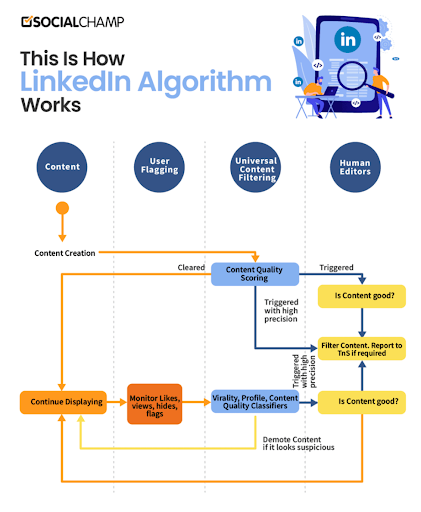
Image Source: Social Champ.
You can use LinkedIn to make your brand or business visible through networking, lead generation, or audience growth.
Its algorithm heavily favors relevancy over recency. Users are shown content that is of interest to them before recent posts.
As a result, LinkedIn displays articles, videos, and job listings that are most relevant to the user—or at least content they are most likely to engage with.
Reason 2: It’s an ideal platform to easily find and pitch your ideal prospects.
LinkedIn is all about making connections. Like any marketing strategy, you need to first think of the outcome you want.
Reverse engineer the entire process.In this case, think:
Who is your ideal client?
Which title do they go by?
What message would make them more likely to say YES to you?
First, here are some recent samples of pitches that I sent to connect with my ideal. In a few minutes, i’ll break down why they work.
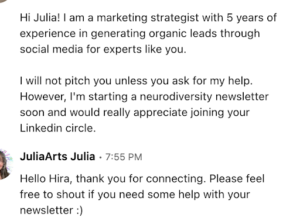
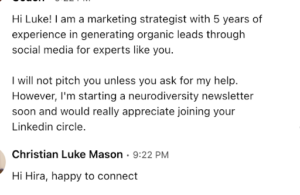
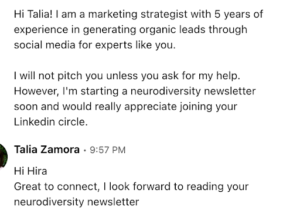

This brings us to…
Reason 3: The LinkedIn job board conveniently helps freelancers find work.
I’ll cut to the chase, here’s what you need to know:
📈 3 people are hired every minute on LinkedIn.
📈 Over 30 million companies use LinkedIn in their business operations.
📈 Executives from every Fortune 500 organization use LinkedIn. These are the most commonly used keywords to find them: CEO, CFO, CIO, COO, Founder, Co-Founder, President…
📈 122 million people received an interview through LinkedIn with 35.5 million having been hired by a person they connected with through the site.
It is definitely worth mentioning here that LinkedIn is not a place for passive action. It’s a 20% inbound and 80% outbound strategy. Which means you’re going to connect with a warm audience using your delicious offers that make them say: This is exactly what I wanted! A job board helps you do that conveniently.
Reason 4: LinkedIn gives you a chance to share your portfolio.
If you don’t have a website, LinkedIn can work as your portfolio. From receiving testimonials to adding separate portfolio sections, it offers all the credibility and social proof you need to wow your prospects.
Newsletters help you build a warm audience.
LinkedIn launched its newsletter feature in 2021. This created a lot of buzz, especially for B2B content creators.
Combining the breadth of a social post with the high value of an email newsletter, you now have the best of both worlds. Here are some tips to grow your subscriber list, from people who collected over a thousand subscribers in a matter of hours!
-
-
- Pick unusual and bold headlines and subheads to hook your audience.
- Publish high-quality content as often as possible.
- Post your newsletter article in relevant groups for maximum exposure.
- Use relevant hashtags.
- Reply to all comments.
- Grow your connections by connecting with three new people every day.
- Be prepared to get a lot of DMs. Answer your DMs and support people in your tribe.
-
On the other hand, some marketers argue that LinkedIn newsletters have a serious drawback. You don’t get access to the email addresses of your LinkedIn newsletter audience, so the content and their contact information only lives on LinkedIn’s platform. And that comes with platform risk—LinkedIn can shut you down.
Here’s my counterargument: It’s all about generating revenue with ease. If sales are happening on the platform, you don’t need to bring the email addresses home.
These are people who haven’t opted in to your personal email list, so it’s an opportunity to reach a market you wouldn’t otherwise reach.
Think about it…
It’s like having your own muffin stand inside a large, popular coffee shop. You’re selling hot delicious strawberry muffins to the constant stream of customers that the coffee shop attracts.
Customers approach you. They pay you right there. They enjoy the muffins.
Do you need to take those customers to your bakery downtown to convince them that your muffins are the best in town?
No!

—> FYI, for those who haven’t been following the case of the missing muffins – this is an actual line, said in an actual court. In 2022. Yep. I love this woman.
So…
If the sale is happening on LinkedIn, then newsletters are a good way to build up credibility and social proof to attract an audience on that platform.
Reason 5: You can directly connect with podcast hosts and industry leaders with your unique offer.
I approached a coach on LinkedIn because one of their articles about mindset resonated with me. One thing led to another and she ended up hiring me to deliver an entire module for her program to help coaches gain visibility on social media. Yeah, dreamy collabs like this start happening if you’re consistent and result-oriented.
Reason 6: You can build an email list for FREE with your ideal prospects.
Want to grow your email list?
Have some specific names in mind you’d jump up and down if they joined?
Reach out to them on LinkedIn explaining the value your newsletter provides to its subscribers. Give them the option to join if that value resonates. More often than not, people will say yes.
Here’s a tried and tested template that you can use to reach out to potential subscribers and grow your list (I showed you some examples of this above):
Hi [first name].
My name is _____ and I’m a [position] for [niche]. I’m not going to pitch you unless you inquire about my services but I’d love to join your circle on LinkedIn.
I’m launching/I have a [name of your newsletter] Newsletter service and I’d really appreciate your feedback on [a topic you’re currently working on].
Thanks.
This is how it looks in action:
Hi Helen,
I’m a marketing strategist for trauma-informed coaches. I’m not going to pitch you unless you inquire about my services but I’d love to join your circle on LinkedIn.
I’m working on launching a Neurodiversity Newsletter and I’d appreciate your feedback on perceptions around self-diagnosis.
Thanks.
Once the conversation gets rolling, you can send them a form to sign up. Trust me, you’ll get some popular names on your list in a matter of days!
Mmkay… but if LinkedIn is that valuable, why aren’t more copywriters using it?
Here are some of the common objections I’ve heard from the writers I know, along with my answer to them…
🙅 “I don’t need LinkedIn. I have a whole other process to land clients.”
– Okay, but is that process as easy and sustainable as leveraging a platform built precisely to help independent contractors connect with clients?
🙅 “I don’t have time for this.”
– You really don’t have time to add thousands of dollars to your monthly income with ease?
🙅 “I don’t understand LinkedIn and I’m completely unaware of how to generate results on this platform.”
– Well, that, we can work on.
Bottom line: If you’re a copywriter, content writer, or marketer, you can easily leverage this platform to generate leads on LinkedIn.
Now coming to the main Q!
How to attract quality leads using LinkedIn without spending money or adding extra hours to your schedule?
Outside of LinkedIn, setting up sustainable systems that target ideal prospects is a long and hard process.
Anyone who says otherwise is lying.
However, with LinkedIn, the algorithm does the hard work for you.
If you haven’t already, here are a couple of things you need to clearly define before moving on to the action list.
Discover Your X-Factor.
This is an important concept that Rob and Kira teach inside The Copywriter Club Underground and The Copywriter Accelerator. Finding your X-factor allows you to stand out from your competitors.
What is the one thing that makes your offer unique?
An X-factor is the key to fill your pipeline with qualified prospects in a saturated market. Here are a few questions to help identify your X-factor.
-
-
- Who is your ideal client? Really specify with real-world examples.
- What services do you offer your clients and why would they choose to do business with you instead of your competitor?
- What makes you different and superior to your competitors?
- What BIG problem can you solve for your clients?
- What makes your client journey more comfortable and exciting than the next person?
-
The next step is to back up your X-Factor with proof.
This proof can be:
-
-
- Testimonials
- Credentials, certifications, and course badges
- Trust badges (companies you’ve helped)
- Case studies
- Data about your results
- Reviews
-
Aside from identifying your X-factor and documenting it as you grow, I also suggest writing out your Elevator pitch and Mission statement, as well as any objections that your clients may have before signing up for your services including answers to how you’ll tackle each of these objections.
Define Ideal Prospects.
Every time I used to think about my ideal prospects, my brain cells screamed this…
When I joined The Copywriter Club Think Tank, Kira broke down the process of identifying ideal clients like teaching it to a preschooler. In my entire 10-year journey as a writer, I never thought It’d be so simple.
Well I’m no Kira Hug, but I can tell you this:
Instead of writing down titles, qualities, and imaginary values, think of real people.
Who would you like to work with in the next three to five years? Make a list of real world people. Do a quick search on how they communicate online. What does their website messaging look like? What are they offering? How can you help them? These (and others like them) are your ideal clients.
Optimize your current website.
If you have a website, prospects are going to pick it apart before hiring you. From your messaging to basic UX, make sure things look neat on your website.
Notice how I use the word neat, because we don’t want to spend hours [or $$$] here. A quick website + offer audit and messaging edits will do the trick.
→ All of this should take you no more than two hours on a quiet evening. Go on, schedule this prepping mode to your calendar right now, so you don’t forget about it.
Remember, no matter what process you use to generate leads, don’t be spammy, salesy, or inconsiderate.
Now that we are prepped and a *leetle beet* confident that we’re set up for success, let’s move to the action plan!
The 5-DAY LinkedIn Action Plan To Get Copywriting Clients, Build Authority, and Land Speaking Gigs on LinkedIn.
DAY 1: Optimize Your Profile. 💃
At this point, I’m assuming you’ve recovered the password to your long-lost LinkedIn account or set up a new one by signing up! For profile optimization, I’m breaking things down visually. Here’s what we’re aiming for…
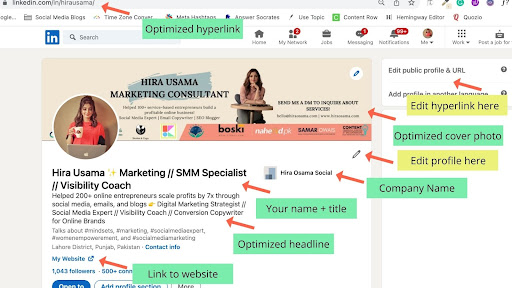
Step 1: Upload a professional headshot to the profile photo section. This is a must. A smiling, vibrant picture of you offers a great deal of connectivity.
Can I add my logo?
No. Company logos work for LinkedIn biz pages (sort of). You’re a human. Flaunt that!
Step 2: When you’re editing your title, add your full name to the “first name” section with an emoji to separate it from your title.
[emoji is optional]
Add your title to the second name section.
A quick keyword search will tell you which keyword has high search volume and low competition. I use this tool for my research along with Google Keyword Planner and Answer The Public.
The reason I encourage doing a keyword search before choosing your title for LinkedIn is the same reason you would do this for any other project you work on; think about your prospect. Start where they start. What titles are they searching for, when they’re looking to solve problems, that you can easily solve for them?
Step 3: The next step is to create a branded banner for LinkedIn cover photo. LinkedIn cover photo size for personal profiles is 1584 by 396 pixels.
FYI, I recommend uploading the same profile photo and banners to all social media channels. This creates a consistent online presence across all platforms.
I use Canva to create all my graphics and would recommend the same to you if you need to create your LinkedIn banner from scratch.
Step 4: Use the “Edit public profile & URL” section to edit your hyperlink. You can either put your title or your name inside the hyperlink. If your name is taken, get creative. Try adding a word or two like: THEHiraUsama or HIREHiraUsama.
Step 5: Write a compelling headline—here’s where all the prepping we did early comes in handy. Using your X-Factor and elevator pitch, craft a stellar headline. You can also use this simple formula that I use to write bios for my clients:
I do [service] to help [target audience] get [results/solution].
Example 1: I write Facebook Ad Copy for B2C SaaS brands to help them scale their revenue by 3x.
Example 2: Coaching eCommerce entrepreneurs using my X framework to help increase their profits by X.
Step 6: Fill out the “About Section”, here’s ONE thing you need to know before you write it:
Even if it’s about you, make it about them…them being your best prospects.
Your messaging should focus on your prospect’s biggest frustration and how your services are tied to solving that problem for them. Treat it like a mini sales page. Include social proof and results from case studies, testimonials, and VOC data to create hard-hitting persuasive messaging.
Step 7: Try to complete as many sections of your portfolio as you can. The workplace, education, certifications, and testimonials build credibility for copywriters.
DAY 2: Create a LinkedIn Content Strategy That Doesn’t Make You Want to Poke Your Eyes Out. 👀
Here’s a mantra I follow… Works well for copywriters, coaches, and service-based entrepreneurs who’re trying to build visibility on any social media platform:
Document. Don’t create.
—> I talked about this on this excellent TCC podcast episode.
It makes everything easy. Simply document your journey, clients, projects, sales, and services. This way, you’ll never run out of stories, and your messages will always come across as relatable and personal.
For tangible action on day 2, I want you to complete these statements about yourself. 👇
-
- I can talk about THIS for hours without preparation…
- I can talk about these additional things for 10 minutes…
- I want to teach THIS to my prospects…
- THIS is my zone of genius…
- THESE are the topics that interest me, but are out of my zone of genius…
Creating Content Categories…
Once you have the answers to these questions, you can start creating your content categories. You can even go ahead and assign a day to each category.
Mine looks like this:
🔥 Sales/Promo: Promote your services on Mondays.
🖊️ Education: Educate your prospects about how your product/service solves their problem on Tuesdays.
🏈 Entertainment/Inspiration: Entertain or inspire your audience on Wednesdays.
✨Vulnerability: Be vulnerable and share a personal story on Thursdays.
⭐ Social values/trendy/controversial: offer your opinion about something making the rounds on the internet on Fridays.
All you need to do is create content under these categories. Each piece of content you create can be tied back to these topics. You can use the same content pillars to create a broader Newsletter content strategy or Youtube/TikTok strategy.
Repurposing Content…
I love repurposing old content. A single email newsletter can be broken down into a week’s worth of social media captions and vice versa. Of course, newsletters are private to your subscribers. They offer something unique that the rest of the world doesn’t have access to. But even without giving away that element, you have plenty of content to work with.
This is how I know it works: Last year, I repurposed three emails into ten different TikTok video scripts, a 90-day Facebook Ad campaign, and one Youtube Video Script for a client. #truestory
Breaking down the anatomy of an excellent social media caption…
Now that you have your content plan ready, it’s time to break down the anatomy of an excellent caption. Every social media caption has a copywriting formula behind it, which makes it persuasive and readable.
Here’s what I’ll tell ya…
Treat every social media caption like a mini-sales page. You are trying to have your prospect say yes to something. Which often means they are saying no to something else. Open with a hook, handle objections, and be clear about your message.
Not every caption needs to hit hard with a copywriting formula. However, as a rule of thumb, three out of five ought to. I personally like to use these two copywriting formulas
✒️ PROMISE → PICTURE → PROOF → PUSH
Let’s see this in action!

Another example…

I also like this formula…
✒️HOOK [STORY/STATS] → PROBLEM → AGITATION → SOLUTION

You can use one of these or a favorite formula that you like!
DAY 3: Grow Your Network By Connecting With Ideal Prospects. 🤝
Here’s the most important part of the action list. The one that we almost always forget: Take action to connect with people. 🤷♀️
As much as it is every independent contractor’s dream… few clients come running to you. Even if your profile is excellent, most clients don’t have the time to go through contractors’ profiles and choose the right person.
This is why clients ask each other for referrals.
This is why people post job opportunities on social media.
… And on job boards.
You’re going to have to do the work and connect with prospects yourself. The ball is in your court. You go out there and connect with your dream client. The action plan for Day 3 entails crafting three different connection messages and sending out twenty messages to your list of ideal clients. Here is a template and some examples that work.
Hi [first name],
I’m a [position] for [prospects/niche] like yourself! Saw you were [personalize the pitch]. I’m not going to pitch you unless you inquire about my services but I would genuinely appreciate if we can connect.
Thanks!
Put this template in action…
Example 1:
Hi Jessey. Nice name! I’m Hira, a conversion copywriter for intuitive coaches like you. I’m not going to pitch you unless you inquire about my services. However, I’d appreciate it if we can connect on LinkedIn.
Talk soon!
Example 2:
Hi Mindy. I was just reading your newsletter and I’d love to connect with you on LinkedIn. I’m a copywriter for mental health coaches like you. I won’t pitch you unless you ask about my services, but I’d appreciate getting to know you in case I want your professional opinion on one of my upcoming projects.
Let’s meet for a coffee chat?
Done? Time to send these out.
It’s fine if you can’t think of any names right now. That clarity will come soon.
A segment of my ideal clients are coaches and therapists in the mental health industry. So I use the search bar on LinkedIn with specific keywords like “therapist”, “coach”, “mental health coach”, “intuitive coach”, “psychologist”, “health and wellness coach” when I’m looking for prospects.

The best part is you can filter these people by location, company, and first-second hand connections. Apart from that, it’s a great way to simply build your network and create a community, for your podcast or newsletter.
How to craft a stellar pitch for basically anything inside and outside of LinkedIn:
Remember the last time a stranger popped inside your DMs with an unsolicited message? Your BS detectors went straight up.
A lot of copywriters are introverts. We hate sending unrequited messages unless we believe them to be genuine. This is why I make it instantly clear that “I will not pitch you unless you inquire about my services” and “I’d simply love to be a part of your network.”
This non-aggressive approach builds trust.
Sharing a unique idea you’re working on [in my case my neurodiversity newsletter was a good conversation starter] with prospects also builds a sense of belonging.
Day 4: Leverage LinkedIn Groups
Disclaimer: You may decide to skip this part. If you do, keep connecting with prospects on Day 4. I am not an active participant in LinkedIn groups. But it’s worth mentioning that this opportunity exists.
LinkedIn groups work like Facebook groups. They’re a tightly knit community of like-minded people coming together to solve problems. And like on Facebook, not all groups are worth your time. You will have to do some digging to find ones that fit you.
The tangible action for today is: Join five to ten LinkedIn groups where your ideal prospects hang out.
❌ Not your competitors.
❌ Not copywriters.
❌ Not marketers.
✅ Only your ideal prospects.
Skim through the discussions. See something good? Add some comments. Or a post. Make sure these are the groups you’d like to engage in regularly.
Day 5: Use LinkedIn’s Job Board.
On Day 5, we’re going to do something incredibly action-oriented.
Step 1: Using the search bar, type in your title. Say, you type in “marketer”, “copywriter”, “editor”, or “social media strategist.” You’re mainly using the keyword that your prospect searches for when they’re looking to hire a specialist like you.
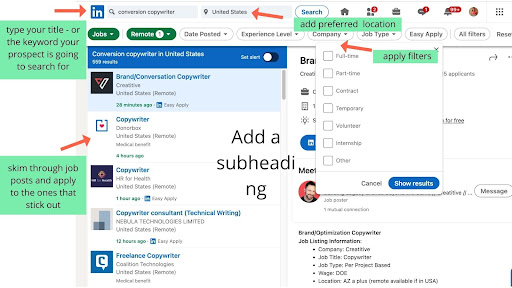
Step 2: Add in filters. Choose your preferred location based on your time zone and other preferences.
Step 3: If you’re like me working from your home office, or better yet, the couch; check the “remote” option.
Step 4: Select experience level and job type.
Step 5: Read the job descriptions carefully. Note down what they’re asking for. Follow the vetting process precisely and apply for the job.
Here, I’ll leave some important reminders to make your job proposals stand out.
-
- Keep a templated cover letter, resume, and portfolio in a google drive folder.Personalize them every time you apply to a gig by adding one or more key elements that the client has asked for inside the job description. It is not about you, it is about them. Tell the recruiters how you can solve problems for them.
-
- Only apply to relevant roles.
-
- Follow the vetting process clearly as stated inside the job application by reading the requirements carefully.
Aaaand we’re done.
Five days.
One hour every day.
The result: You now have LinkedIn set up, optimized, and running to generate leads for your business.
For sustainable results, repeat actions from days 3 & 5 → 1 – 2x every week.
As an advocate of creating ease and sustainability in business, my goal isn’t to have you add more stuff to your list. So I’m going to advise you to audit and tailor your journey accordingly. Spend more time doing activities that add to your income stream.
Let’s answer a few questions…
How can I build an email list through LinkedIn?
When you reach out to your prospects for connection requests via LinkedIn messages, mention your newsletter. State the value it provides to its subscribers. Add the big problem it can solve for the prospect. Either ask for the signup or don’t—wait till they show interest and then casually throw in: oh I can sign you up for my email list if you want.
Viola.
You’re not only adding people to the list, but you’re also improving segmentation by actively reaching the highly targeted audience. These people are likely to refer you, buy from you, or collaborate with you in the future.
I’d like to get featured on podcasts. Is there a way to do that on LinkedIn?
Many podcast hosts actively seek guests for their shows on LinkedIn. Whether or not they are actively looking for guests, you can send a direct pitch to the host and claim a chance to get featured on their podcast!
How to get guest posting opportunities from LinkedIn?
Connect with editors and producers of your favorite publications, magazines, and blogs on LinkedIn. The search bar is your hero. Everything you need is inside that small box with a magnifying glass. 🔍
Pitch your idea. Make sure it’s incredible. Get published!
How do I measure success on LinkedIn?
Success on any social media platform does not lie in the number of likes, comments, or follows. These are misleading KPIs.
Captions that get likes are usually top-of-the-world educational posts or controversial rants. If you want to measure the success of any strategy, measure it by additional revenue.
How much money are you making with a particular lead generation strategy?
That’s your success rate.
Wrapping Up…
The five-day action plan helps copywriters, marketers, and coaches connect with ideal prospects. This is your chance to reach out to people you admire from afar, impress and collaborate with.
To make it a successful attempt…be consistent.
Remember, begin with stating your goal. Are you looking to add revenue? Are you looking for collaboration opportunities? Are you aiming to build your email list? Or are you trying to build authority and credibility with podcasts and guest posts?
This clarity will ensure all your actions remain intentional, measurable, and purposeful throughout your marketing journey.
Go on… Go out there and fill up your pipeline with incredible prospects who can’t wait to work with you!
About The Author
 Hira Usama is a Visibility Coach, Conversion Copywriter, and Digital Marketing Strategist who has been writing copy for 10+ years. Currently, she’s writing scripts and emails for B2B brands and agencies. She’s a mom, tea lover, mindset geek, and advocate for building sustainability and ease for WOC business owners. Hop on her weekly newsletter: The Atypical Entrepreneur or work with her 1:1 inside the Visibility Coaching Program!
Hira Usama is a Visibility Coach, Conversion Copywriter, and Digital Marketing Strategist who has been writing copy for 10+ years. Currently, she’s writing scripts and emails for B2B brands and agencies. She’s a mom, tea lover, mindset geek, and advocate for building sustainability and ease for WOC business owners. Hop on her weekly newsletter: The Atypical Entrepreneur or work with her 1:1 inside the Visibility Coaching Program!

